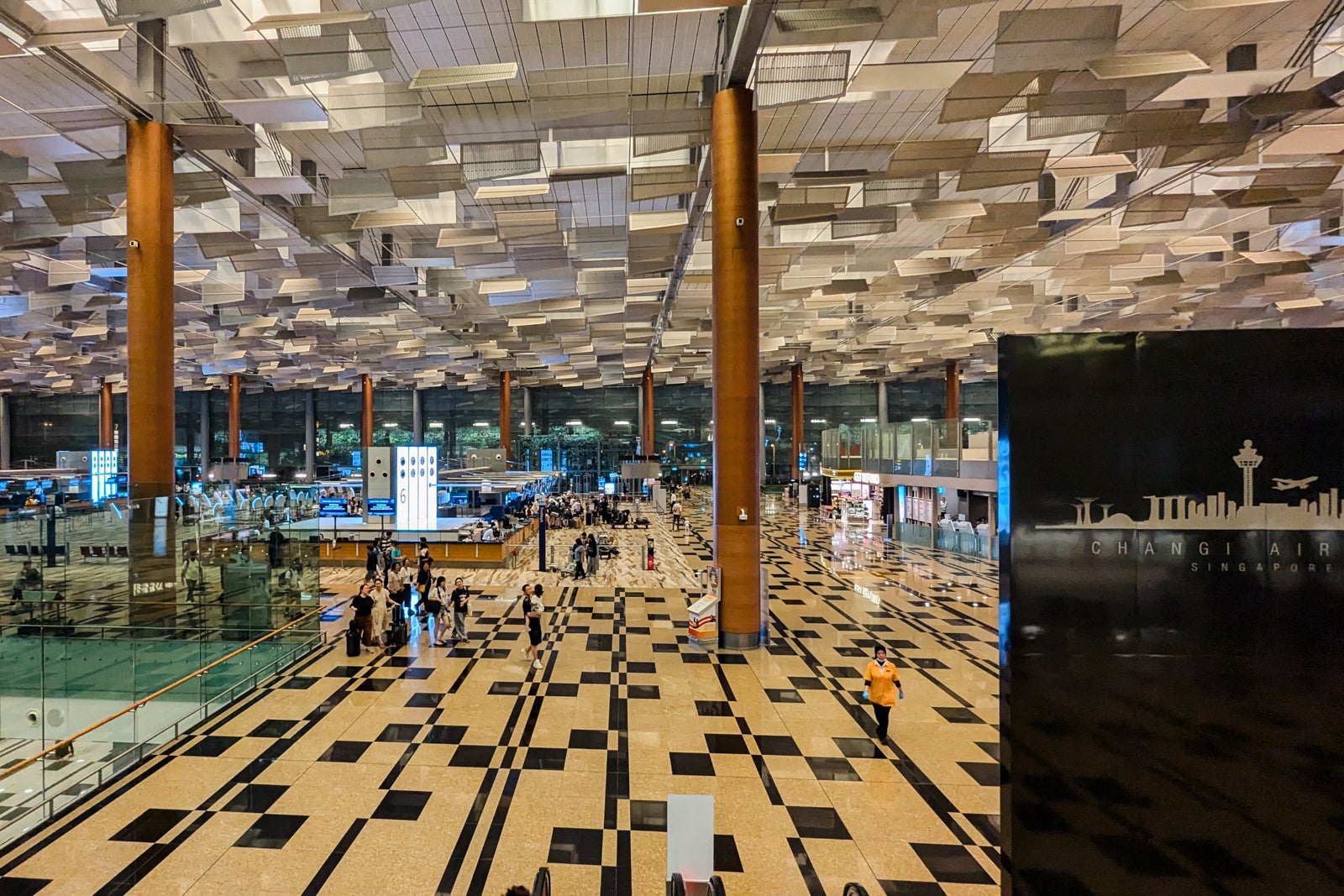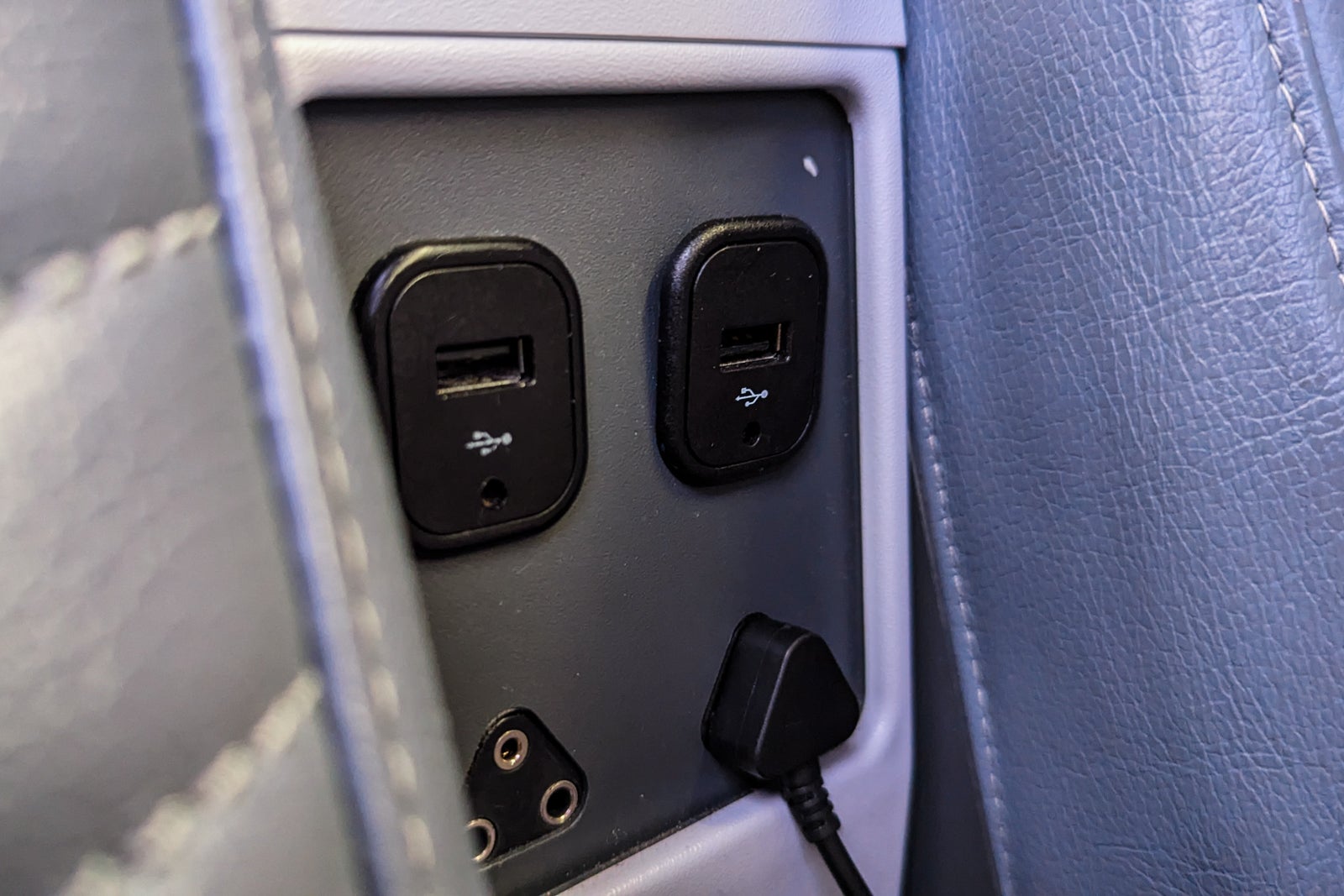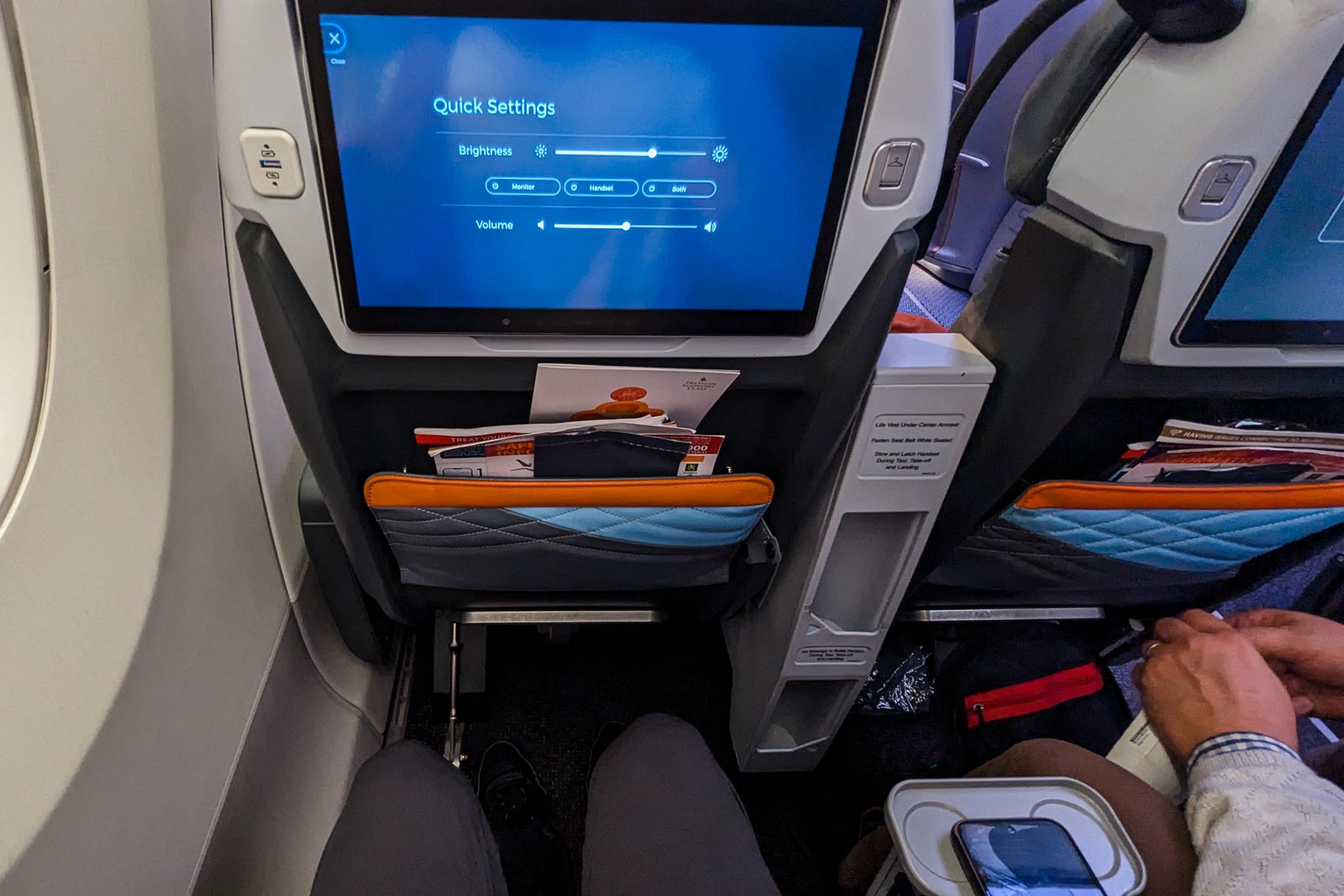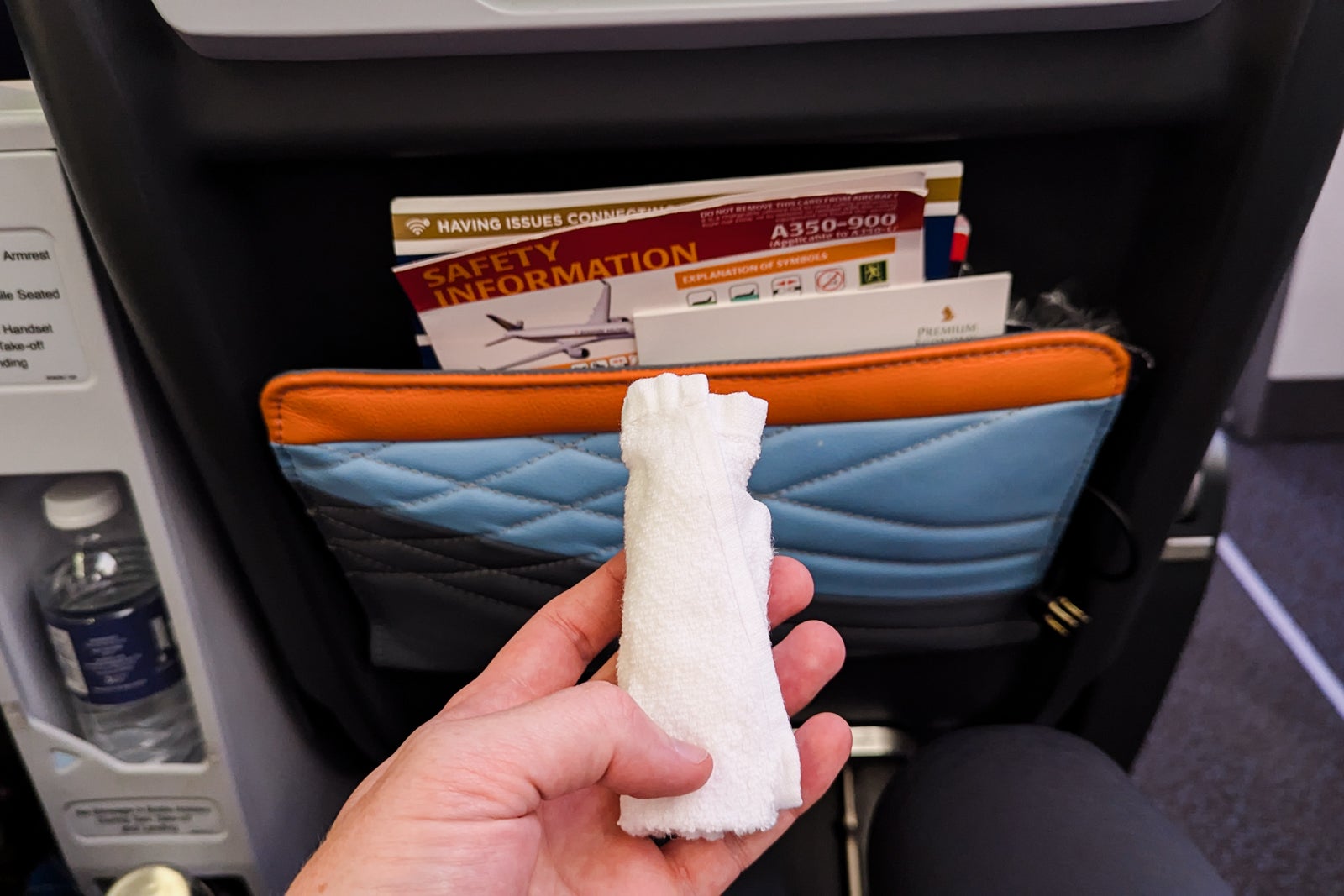Editor’s note: Singapore Airlines provided TPG with a complimentary round-trip flight to Singapore so that we could get an inside look at both the airline’s refreshed premium economy product and the new route. The opinions expressed below are entirely those of the author and weren’t subject to review by the airline or any external entity.
Quick take: One of the world’s leading airlines delivers an impressive step up from economy, but there is still some minor room for improvement.
Pros
- Singapore Changi Airport (SIN) remains a fantastic ground experience for passengers.
- The small and intimate cabin contains just 24 seats with wide seats and generous legroom.
- Champagne is available, and hearty meals are served on beautiful ceramic plates.
Cons
- Passengers don’t get predeparture drinks, and during the flight, drinks are offered in plastic and paper cups.
- There are no dedicated crew or bathrooms for premium economy.
- Cash prices are at least twice the price of economy.
Can one of the world’s best airlines deliver a premium economy that’s up to snuff?
Singapore Airlines is renowned around the globe for its passenger experience, from its award-winning hub at SIN to its talented cabin crew in their iconic sarong kebaya uniforms (introduced some 50 years ago). The airline has a widespread route network, including the world’s longest flight from New York’s John F. Kennedy International Airport (JFK) to SIN, as well as various fifth-freedom routes across the Atlantic and Pacific oceans.
Growing up in Adelaide, South Australia, Singapore Airlines was one of the only international airlines flying to my hometown of around 1 million people.
I’ve flown Singapore Airlines more times than I can count since I was a kid, and so far, I’ve never had a bad flight with the storied carrier.
The airline recently upgraded its premium economy product to include enhanced dining and new amenity kits, investing in what has become an increasingly popular class of service. So, I decided to try the product on its new route from SIN to London Gatwick Airport (LGW) on its Airbus A350.
Here’s what the experience was like.

How to book premium economy on Singapore Airlines
Round-trip cash fares in Singapore Airlines’ premium economy product are usually at least twice — and sometimes as high as three times — the cost of regular economy. Business class is usually around twice the cost of premium economy.
Singapore Airlines’ new SQ312 service to LGW operates four days per week. Flights depart SIN Friday to Monday at 11:55 p.m. and arrive at LGW about 13 hours later at approximately 6:25 a.m. Flights going the other way depart LGW Saturday to Tuesday at 10:15 a.m., landing at SIN at around 6:20 a.m. the following day. (All times are local.)
The new LGW service complements the carrier’s existing four daily flights to London’s Heathrow Airport (LHR).
Here are the ranges of airfare and award redemptions I could find in all three cabins on this route over the next year.
| Round-trip prices | Economy | Premium economy | Business class |
| Cash | $1,070 to $2,580 | $2,860 to $4,140 | $5,450 to $8,170 |
| Singapore Airlines KrisFlyer miles | 84,000 miles plus $183 | 142,000 miles plus $338 | 207,000 miles plus $338 |
| Air Canada Aeroplan points | 100,000 miles plus $250 | Unavailable | Unavailable |
Luckily, KrisFlyer miles are easy to earn and redeem. Singapore Airlines doesn’t offer a cobranded credit card in the U.S. However, the airline partners with several major transferable rewards programs, including American Express Membership Rewards, Capital One, Citi ThankYou Rewards and Chase Ultimate Rewards, all at a 1:1 transfer ratio.
The following cards all currently offer strong welcome bonuses that you could easily convert to KrisFlyer miles:
- American Express® Gold Card
- The Platinum Card® from American Express
- The Business Platinum Card® from American Express
- Capital One Venture Rewards Credit Card
- Capital One Venture X Rewards Credit Card
- Chase Sapphire Preferred® Card
- Ink Business Preferred® Credit Card
Checking into premium economy on Singapore Airlines
If you’re departing from SIN, don’t miss The Jewel waterfall outside of security in Terminal 3. It’s a spectacular, free-to-visit indoor rainforest so popular that other airports seem to have taken inspiration.

A premium economy ticket on Singapore Airlines (whether booked with cash or KrisFlyer miles) includes free seat selection and — for flights to and from North America — two checked bags weighing up to 50 pounds each. For flights to other destinations, premium economy fares include one checked bag that can weigh up to 77 pounds.
As you might expect, the airline has a huge check-in area at its home hub in Terminal 3. There are plenty of self-service kiosks and manned counters; premium economy passengers have dedicated check-in areas.



I expected the priority check-in area to be easy to find and grand like the one Emirates offers at Dubai International Airport (DXB). However, all premium economy passengers were relegated to just two check-in counters in row 9 — the same number given to cabin crew checking baggage before signing on. While there was no line to check in, I was surprised at how low-key this priority check-in area was given that the airline operates premium economy on most long-haul routes and pitches it as an elevated experience.

It’s easy to see why SIN is consistently awarded as the world’s best airport. It feels more like a luxury shopping mall than an airport terminal thanks to its noise-reducing carpeting, numerous shiny boutiques and plentiful activities to entertain children and adults. It even includes a butterfly garden and a free 24-hour movie theater.

Despite being busy with a bank of European flights all leaving around midnight, the terminal felt spacious and peaceful — not words I would usually use to describe an airport.

SIN’s Terminal 3 is unique because passengers clear security at the gate rather than just after check-in. In my case, gates A1 through A8 shared a single, large security checkpoint.

While premium economy passengers were not offered a priority security queue, the process was smooth, calm and efficient.

Only a few flights were departing from the large eight-gate space at this late hour, so hundreds of seats (complete with charging points) were available for passengers waiting to board.

Staff called boarding by group numbers and instructed passengers to remain seated until their group was called.
Premium economy passengers boarded through the same lane as economy but were called to board with Group 3 (along with KrisFlyer Gold and Star Alliance Gold members). Regular economy passengers boarded afterward in Group 4.

With a 13-hour overnight flight ahead of us, nobody seemed in a huge rush to board and start sitting, which made for an orderly process.
How comfortable was premium economy on Singapore Airlines?
| Economy | Premium economy | Business class | |
| Layout | 3-3-3 | 2-4-2 | 1-2-1 |
| Seat pitch | 32 inches | 38 inches | 60 inches (78 inches in bed mode) |
| Seat recline | 6 inches | 8 inches | Fully flat |
| Seat width | 17.3 inches | 19 inches | 28 inches |
| Screen size | 11.1 inches | 13.3 inches | 18 inches |
The premium economy cabin was surprisingly small, with just 24 seats spread across three rows directly behind the second luxurious business-class cabin.

The front row seats in row 31 have a little extra legroom due to the bulkhead in front; they are an especially good choice if traveling as a couple — although you won’t be able to stow a personal item in front of you.

At 6 feet tall, I found the legroom in row 32 generous, and I had a bit more personal space than in economy.

The small size of the cabin had both positives and negatives.
While intimate and exclusive, it also felt a little cramped, with walls at the front and back. For example, there was no way to move across from one aisle to the other without going halfway back through the economy cabin behind.

The right side armrest had buttons to manually recline the seatback and pop out the legrest.


Rather than a footrest folding out from the bottom of the legrest, the footrest came down from the seat in the front. The seatback in front was also outfitted with a large and sturdy literature pocket along with a water bottle holder; this was already stocked with a bottle of water for each premium economy passenger.

There was a universal power outlet for each seat in the center armrest, a USB-A port next to the inflight entertainment screen and another next to the headphone jack between the seats.



Unfortunately, this modern A350 aircraft did not have USB-C ports, wireless charging or Bluetooth connectivity.
A tray table that popped out of the armrest was large and sturdy enough for a full-size MacBook.

I also liked the adjustable reading light next to the headrest; it was handy for reading the menu without disturbing passengers trying to rest on this overnight flight.

Amenities in Singapore Airlines premium economy
A pillow and a blanket wrapped in plastic were waiting on each seat when passengers boarded.

Both items were plush and larger than you would expect to receive in economy.


The carrier also provided decent over-ear noise-canceling headphones — another luxury perk that made this long-haul flight more comfortable.

One of the enhancements the airline has promoted in premium economy this year is a new amenity kit by the brand Out of the Woods. I didn’t care for the crumpled bag it came in (similar to Virgin Atlantic’s premium economy amenity kit), and the contents — slippers, an eye mask and an airline-branded lip balm — were fairly basic. It was better than nothing, though.

More impressive was the large, crisp seatback touchscreen.

It was filled with 43 new releases, including “Kung Fu Panda 4”, “Arthur the King” and “Dune: Part Two.” I enjoyed watching “Ricky Stanicky” — a silly but funny way to pass the time to London.



If I hadn’t wanted to lean forward to tap the screen, I could use the hand-held remote that popped out of the center armrest console to control the screen.

There was unlimited Wi-Fi at no charge for KrisFlyer members in all cabins. While this initially seemed like a luxurious perk, my various tests of the speeds throughout the flight never registered more than a poor 2 Mbps download or 1 Mbps upload. I quickly gave up on using it.
Given the small cabin — just three rows — it wasn’t surprising that there were no dedicated bathrooms for premium economy passengers. Still, it was a little disappointing. Instead, five bathrooms were shared with the economy cabin behind, and there were regular lines to use them.
They were kept clean but were tight to move around in.


How was the food in Singapore Airlines premium economy?
I was surprised that I did not receive a welcome drink during the boarding process, as this is common in premium economy on other carriers — especially ones as well regarded as Singapore Airlines.
I was offered a hot towel that I gladly accepted after the sticky tropical heat of Singapore.

Shortly after takeoff, the crew distributed printed menus and began serving dinner.
Since I was flying in premium economy, I could have used the airline’s Book The Cook service. This would have allowed me to choose from a much larger selection of entree dishes, provided I had selected it online more than 24 hours in advance.
While Book the Cook is an awesome perk available to passengers in premium economy and above, I decided to stick with the regular menu to try what most other passengers would be eating.
Given how long the flight was, I had expected the first service to be prolonged a bit; I imagined I would receive a round of drinks or perhaps a drink with some mixed nuts before dinner. However, the staff served the main meal quickly after takeoff. I guess because of the late departure hour, this method allowed guests to eat quickly and then get some rest.
I was excited to try the recently enhanced dining options, and there were some hits and misses. I was pleasantly surprised to see Charles de Cazanove Brunt NV Champagne, which retails for around $38 per bottle on the ground. Proper Champagne in premium economy, as opposed to sparkling wine, was a real treat; however, I wish they had served it in glassware rather than a plastic tumbler.

For dinner, there was a smoked salmon salad appetizer along with just two entree course options:
- Pork fricassee with lentils, lyonnaise potatoes, blanched broccolini and roast carrots
- Kuay teow neua (Thai braised beef noodles with beef meatballs and braised beef)
Dinner came with cheese, crackers and garlic bread on the side, and dessert was a chocolate orange cake with raspberry compote.
The meal was served on a single tray, and everything looked reasonably well presented. However, I wish they removed the plastic and foil covers before handing the trays to the passengers.

I was expecting a third main entree option — perhaps vegetarian or something without pork or red meat (which some customers avoid).
I chose the beef noodles, and they were excellent. The beef was juicy, and the noodles were properly cooked without sticking together.
The beautiful ceramic crockery was a real step above economy class, and metal cutlery is always welcome.

The entire dinner service was fast: It was fully cleared within 90 minutes of departure. This gave passengers plenty of time to rest on the way to London.
Snacks — including sandwiches, fresh fruit, muffins, nuts and chips — were available from the rear galley between meal services. I slept for most of the flight, so I didn’t try this out.
Due to a recent turbulence incident, Singapore Airlines is taking an extra cautious approach to meal service. Meals are not served anywhere along the flight path where pilots see a potential for turbulence, so breakfast happened a lot sooner than normal. It was served three hours before arriving in London, with some bumpier weather expected a bit closer to landing.
Breakfast included strawberry yogurt with fresh fruit, a croissant and a choice of tea, coffee or juice with two entree options:
- Vegetarian omelet with grilled mushroom, baked tomato, garlic and wilted greens
- Chai tow kueh (a savory fried carrot cake with prawns and preserved turnips)
Again, I was surprised not to see a third option on the menu. The meal was all served on one tray.

Based on the flight attendant’s recommendation, I chose the Singaporean carrot cake entree. I wasn’t quite sure what to expect, but it was delicious. It was a hearty seafood-forward dish with a delicious spicy sauce that filled me up for the remaining three hours of the flight.

I do wish the juice and hot drink had been served in proper glassware or ceramic mugs rather than plastic and paper cups. This is an easy way to make a premium economy experience feel more elegant.
Just like on every other Singapore Airlines flight I’ve taken, the crew on my premium economy flight to London was polished, professional and welcoming. Their rigorous training was evident. No request was too much trouble, and everything was delivered graciously with a warm smile.
The hospitality is more formal; the crew members probably won’t crack many jokes or engage in much frivolous small talk. But that said, it’s unlikely you’ll find a bad crew member on your next Singapore Airlines flight.

Was Singapore Airlines premium economy worth it?
This class of service is a noticeable step up from Singapore Airlines economy class, which is already a world-class coach product.
The seats are wider, and there’s more legroom. Seats recline more than in economy, and the legrest makes the flight more comfortable. Plus, receiving Champagne in premium economy was a real treat, as was the metal cutlery.
Still, Singapore’s premium economy has some room for improvement. The lack of dedicated crew and lavatories makes this more of an “economy plus” experience rather than “business lite.” The lack of proper glassware and predeparture beverages was disappointing. The airline could add a third option to the entrees for dinner and breakfast, though next time, I would use the fantastic Book The Cook service.
Emirates and KLM remain the most impressive premium economy products I’ve flown, but Singapore Airlines would probably just scrape its way into the top five.
Since it tends to be at least twice the price of an already excellent economy product, I would probably be happy to stick with economy class on my next flight to Singapore. However, if you can find a slightly less expensive upcharge over economy — either with cash or miles — then you can be assured it’s a comfortable way to travel on one of the world’s best airlines.





